Biermann Ch. Handbook of Pulping and Papermaking
Подождите немного. Документ загружается.

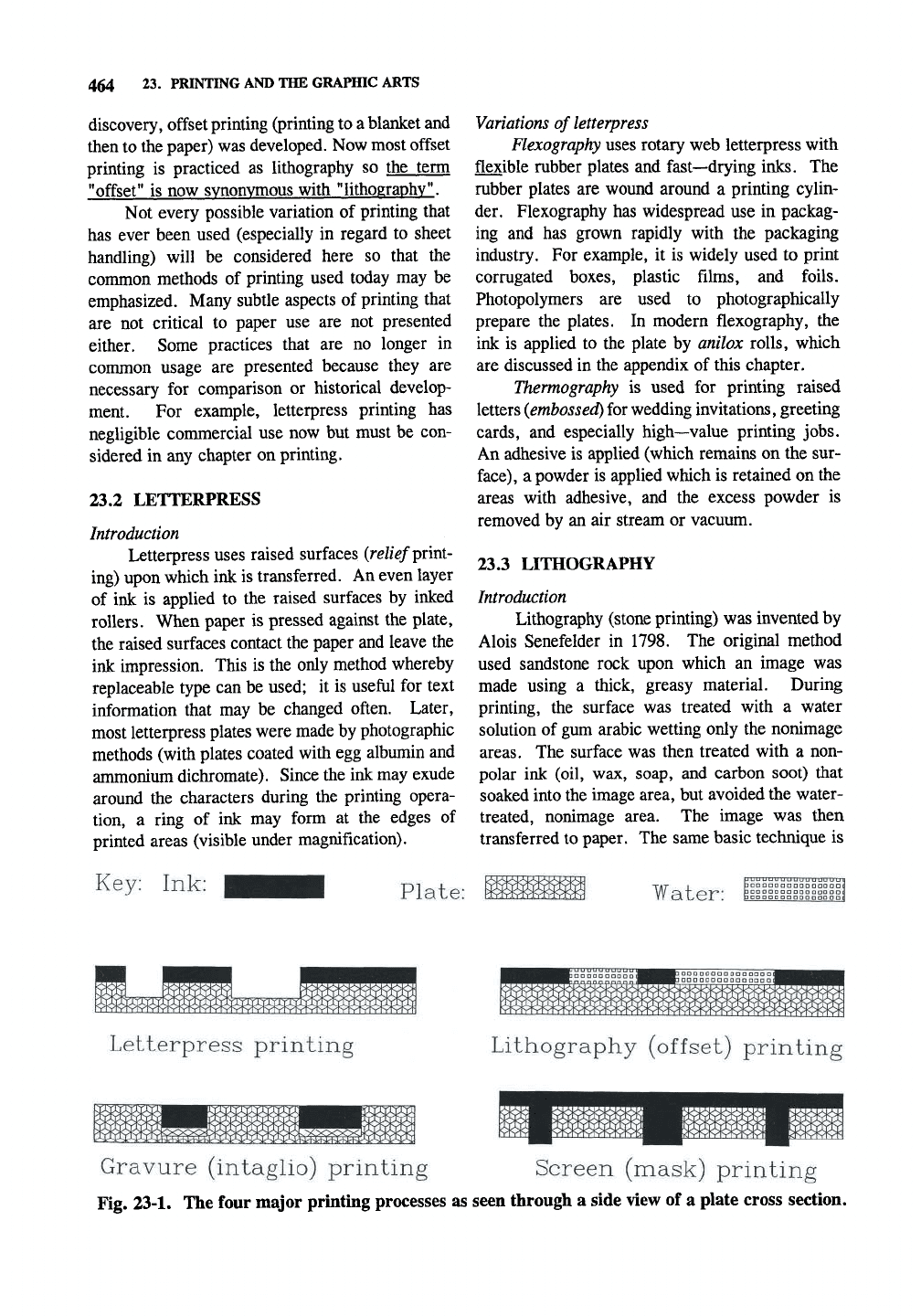
464 23. PRINTING AND THE GRAPHIC ARTS
discovery, offset printing (printing to a blanket and
then to the paper) was developed. Now most offset
printing is practiced as lithography so the term
"offset" is now svnonvmous with "lithography".
Not every possible variation of printing that
has ever been used (especially in regard to sheet
handling) will be considered here so that the
common methods of printing used today may be
emphasized. Many subtle aspects of printing that
are not critical to paper use are not presented
either. Some practices that are no longer in
common usage are presented because they are
necessary for comparison or historical develop-
ment. For example, letterpress printing has
negligible conmiercial use now but must be con-
sidered in any chapter on printing.
23.2 LETTERPRESS
Introduction
Letterpress uses raised surfaces (re/zV/print-
ing) upon which ink is transferred. An even layer
of ink is applied to the raised surfaces by inked
rollers. When paper is pressed against the plate,
the raised surfaces contact the paper and leave the
ink impression. This is the only method whereby
replaceable type can be used; it is useful for text
information that may be changed often. Later,
most letterpress plates were made by photographic
methods (with plates coated with egg albumin and
ammonium dichromate). Since the ink may exude
around the characters during the printing opera-
tion, a ring of ink may form at the edges of
printed areas (visible under magnification).
Variations
of
letterpress
Flexography
uses rotary web letterpress with
flexible rubber plates and fast—drying inks. The
rubber plates are wound around a printing cylin-
der, Flexography has widespread use in packag-
ing and has grown rapidly with the packaging
industry. For example, it is widely used to print
corrugated boxes, plastic films, and foils.
Photopolymers are used to photographically
prepare the plates. In modern flexography, the
ink is applied to the plate by anilox rolls, which
are discussed in the appendix of this chapter.
Thermography is used for printing raised
letters
{embossed)
for wedding invitations, greeting
cards,
and especially high—value printing jobs.
An adhesive is applied (which remains on the sur-
face),
a powder is applied which is retained on the
areas with adhesive, and the excess powder is
removed by an air stream or vacuum.
23.3 LITHOGRAPHY
Introduction
Lithography (stone printing) was invented by
Alois Senefelder in 1798. The original method
used sandstone rock upon which an image was
made using a thick, greasy material. During
printing, the surface was treated with a water
solution of gum arable wetting only the nonimage
areas.
The surface was then treated with a non-
polar ink (oil, wax, soap, and carbon soot) that
soaked into the image area, but avoided the water-
treated, nonimage area. The image was then
transferred to paper. The same basic technique is
Key: Ink:
Plate: Water:
Letterpress printing
Lithography (offset) printing
^S^^^^^^i^^.
Gravure (intagho) printing Screen (mask) printing
Fig. 23-1. The four major printing processes as seen through a side view of a plate cross section.
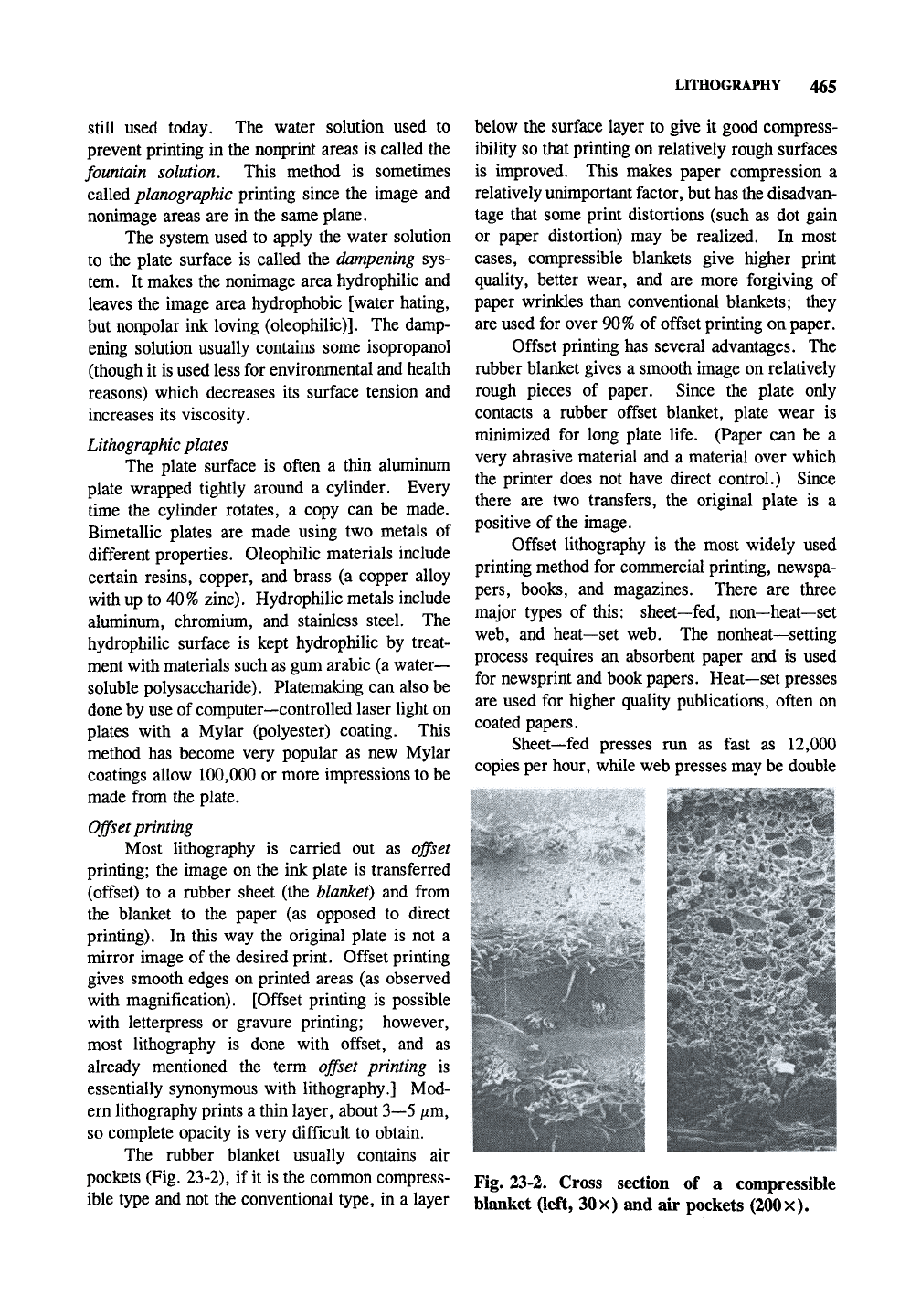
LITHOGRAPHY 465
Still used today. The water solution used to
prevent printing in the nonprint areas is called the
fountain solution. This method is sometimes
called planographic printing since the image and
nonimage areas are in the same plane.
The system used to apply the water solution
to the plate surface is called the dampening sys-
tem. It makes the nonimage area hydrophilic and
leaves the image area hydrophobic [water hating,
but nonpolar ink loving (oleophilic)]. The damp-
ening solution usually contains some isopropanol
(though it is used less for environmental and health
reasons) which decreases its surface tension and
increases its viscosity.
Lithographic
plates
The plate surface is often a thin aluminum
plate wrapped tightly around a cylinder. Every
time the cylinder rotates, a copy can be made.
Bimetallic plates are made using two metals of
different properties. Oleophilic materials include
certain resins, copper, and brass (a copper alloy
with up to 40% zinc). Hydrophilic metals include
aluminum, chromium, and stainless steel. The
hydrophilic surface is kept hydrophilic by treat-
ment with materials such as gum arable (a water-
soluble polysaccharide). Platemaking can also be
done by use of computer—controlled laser light on
plates with a Mylar (polyester) coating. This
method has become very popular as new Mylar
coatings allow 100,000 or more impressions to be
made from the plate.
Offset
printing
Most lithography is carried out as offset
printing; the image on the ink plate is transferred
(offset) to a rubber sheet (the blanket) and from
the blanket to the paper (as opposed to direct
printing). In this way the original plate is not a
mirror image of the desired print. Offset printing
gives smooth edges on printed areas (as observed
with magnification). [Offset printing is possible
with letterpress or gravure printing; however,
most lithography is done with offset, and as
already mentioned the term offset printing is
essentially synonymous with lithography.] Mod-
ern lithography prints a thin layer, about 3—5 /*m,
so complete opacity is very difficult to obtain.
The rubber blanket usually contains air
pockets (Fig. 23-2), if it is the common compress-
ible type and not the conventional type, in a layer
below the surface layer to give it good compress-
ibility so that printing on relatively rough surfaces
is improved. This makes paper compression a
relatively unimportant factor, but has the disadvan-
tage that some print distortions (such as dot gain
or paper distortion) may be realized. In most
cases,
compressible blankets give higher print
quality, better wear, and are more forgiving of
paper wrinkles than conventional blankets; they
are used for over 90% of offset printing on paper.
Offset printing has several advantages. The
rubber blanket gives a smooth image on relatively
rough pieces of paper. Since the plate only
contacts a rubber offset blanket, plate wear is
minimized for long plate life. (Paper can be a
very abrasive material and a material over which
the printer does not have direct control.) Since
there are two transfers, the original plate is a
positive of the image.
Offset lithography is the most widely used
printing method for commercial printing, newspa-
pers,
books, and magazines. There are three
major types of this: sheet—fed, non—heat—set
web,
and heat—set web. The nonheat—setting
process requires an absorbent paper and is used
for newsprint and book papers. Heat—set presses
are used for higher quality publications, often on
coated papers.
Sheet—fed presses run as fast as 12,000
copies per hour, while web presses may be double
Fig. 23-2. Cross section of a compressible
blanket (left, 30 x) and air pockets (200x).
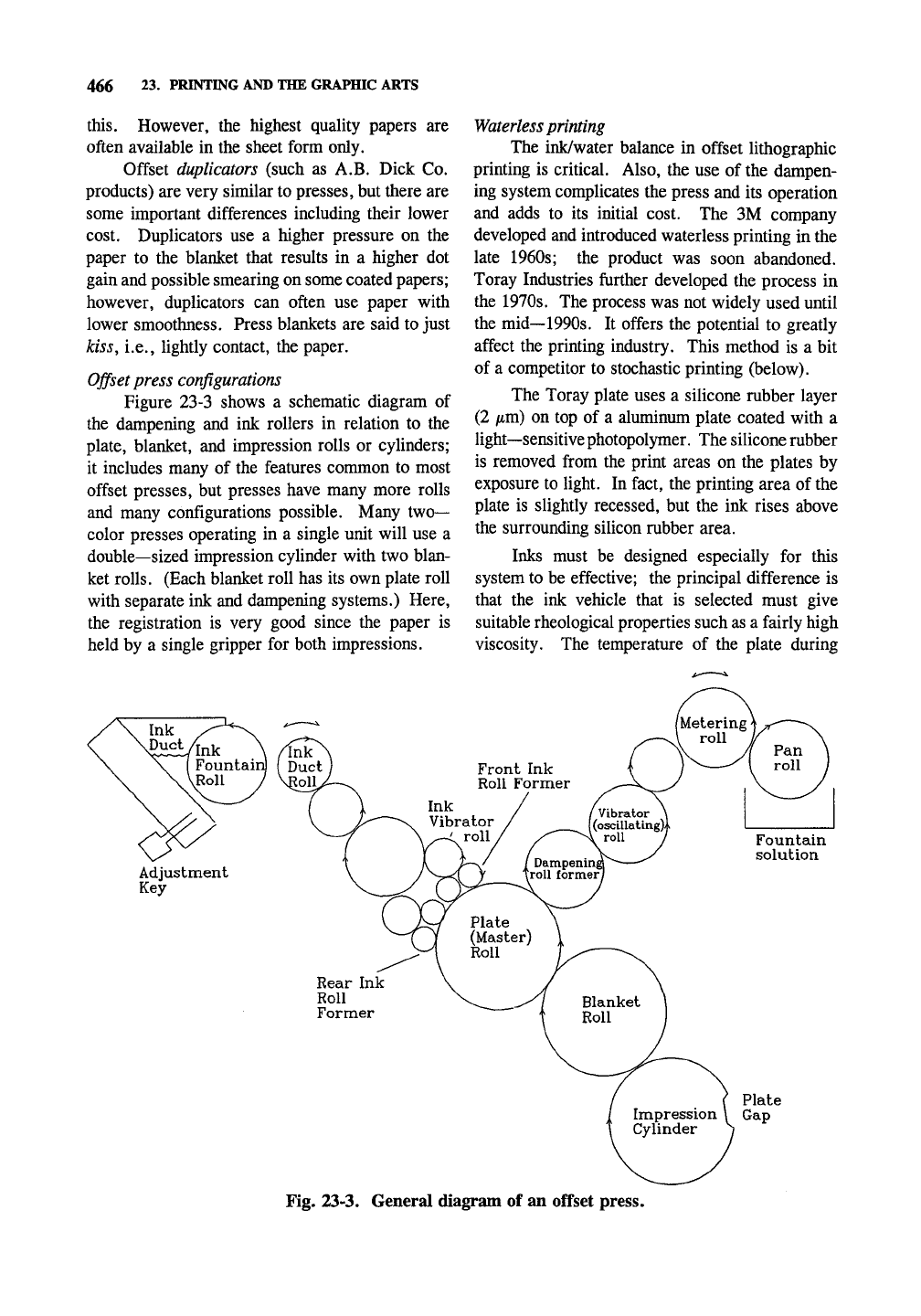
466 23. PRINTING AND THE GRAPHIC ARTS
this.
However, the highest quality papers are
often available in the sheet form only.
Offset duplicators (such as A.B. Dick Co.
products) are very similar to presses, but there are
some important differences including their lower
cost. Duplicators use a higher pressure on the
paper to the blanket that results in a higher dot
gain and possible smearing on some coated papers;
however, duplicators can often use paper with
lower smoothness. Press blankets are said to just
kiss,
i.e., lightly contact, the paper.
Offset
press configurations
Figure 23-3 shows a schematic diagram of
the dampening and ink rollers in relation to the
plate, blanket, and impression rolls or cylinders;
it includes many of the features common to most
offset presses, but presses have many more rolls
and many configurations possible. Many two-
color presses operating in a single unit will use a
double—sized impression cylinder with two blan-
ket rolls. (Each blanket roll has its own plate roll
with separate ink and dampening systems.) Here,
the registration is very good since the paper is
held by a single gripper for both impressions.
Waterless
printing
The ink/water balance in offset lithographic
printing is critical. Also, the use of the dampen-
ing system complicates the press and its operation
and adds to its initial cost. The 3M company
developed and introduced waterless printing in the
late 1960s; the product was soon abandoned.
Toray Industries further developed the process in
the 1970s. The process was not widely used until
the mid—1990s. It offers the potential to greatly
affect the printing industry. This method is a bit
of a competitor to stochastic printing (below).
The Toray plate uses a silicone rubber layer
(2
iivd)
on top of a aluminum plate coated with a
light—sensitive photopolymer. The silicone rubber
is removed from the print areas on the plates by
exposure to light. In fact, the printing area of the
plate is slightly recessed, but the ink rises above
the surrounding silicon rubber area.
Inks must be designed especially for this
system to be effective; the principal difference is
that the ink vehicle that is selected must give
suitable rheological properties such as a fairly high
viscosity. The temperature of the plate during
Adjustment
Key
Rear Ink
Roll
Former
Plate
Impression \ Gap
Cylinder
Fig. 23-3. General diagram of an offset press.
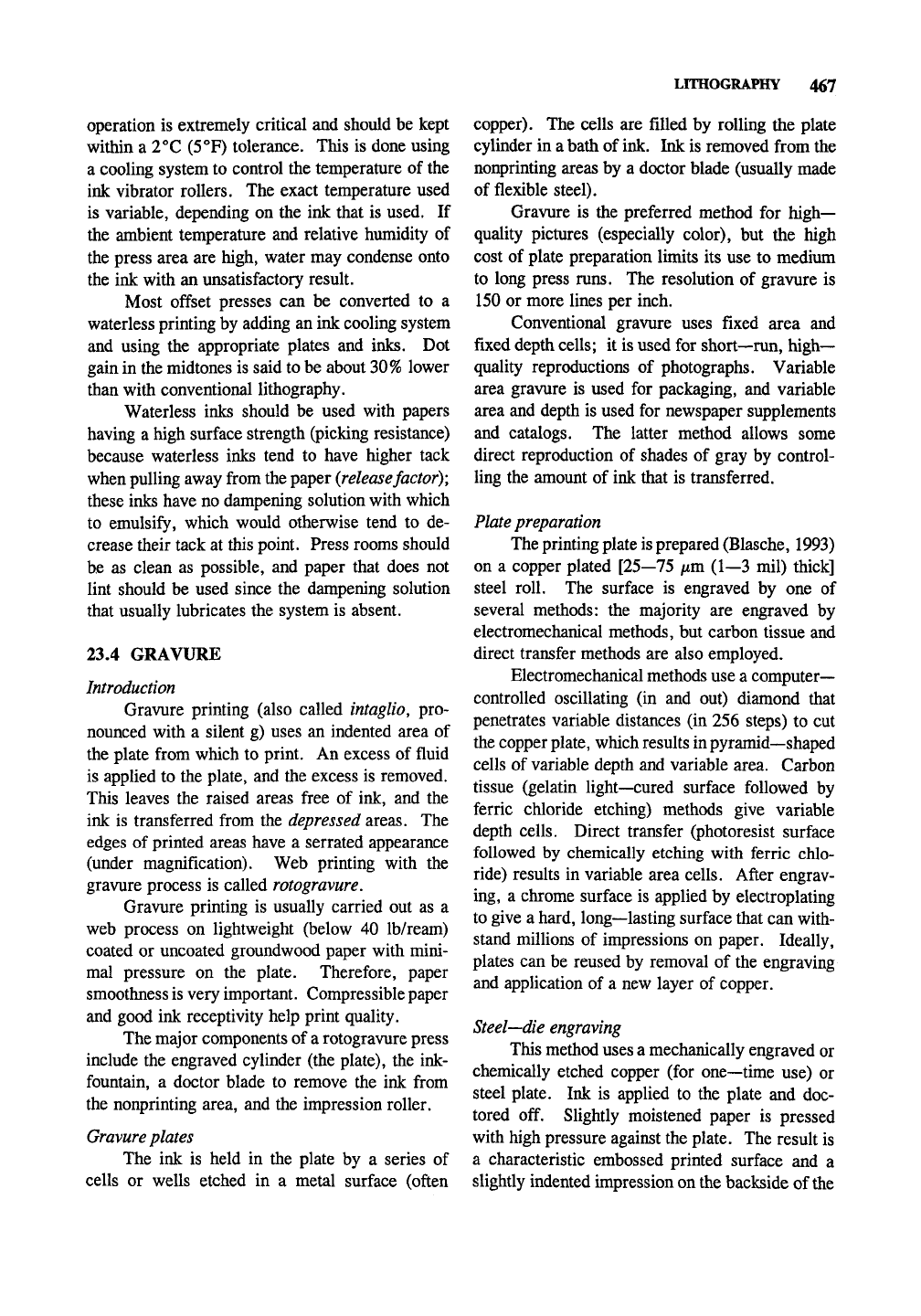
LITHOGRAPHY 467
operation is extremely critical and should be kept
within a 2°C (5°F) tolerance. This is done using
a cooling system to control the temperature of the
ink vibrator rollers. The exact temperature used
is variable, depending on the ink that is used. If
the ambient temperature and relative humidity of
the press area are high, water may condense onto
the ink with an unsatisfactory result.
Most offset presses can be converted to a
waterless printing by adding an ink cooling system
and using the appropriate plates and inks. Dot
gain in the midtones is said to be about 30% lower
than with conventional lithography.
Waterless inks should be used with papers
having a high surface strength (picking resistance)
because waterless inks tend to have higher tack
when pulling away from the paper {releasefactor);
these inks have no dampening solution with which
to emulsify, which would otherwise tend to de-
crease their tack at this point. Press rooms should
be as clean as possible, and paper that does not
lint should be used since the dampening solution
that usually lubricates the system is absent.
23.4 GRAVURE
Introduction
Gravure printing (also called intaglio, pro-
nounced with a silent g) uses an indented area of
the plate from which to print. An excess of fluid
is applied to the plate, and the excess is removed.
This leaves the raised areas free of ink, and the
ink is transferred from the depressed areas. The
edges of printed areas have a serrated appearance
(under magnification). Web printing with the
gravure process is called rotogravure.
Gravure printing is usually carried out as a
web process on lightweight (below 40 lb/ream)
coated or uncoated groundwood paper with mini-
mal pressure on the plate. Therefore, paper
smoothness
is
very important. Compressible paper
and good ink receptivity help print quality.
The major components of a rotogravure press
include the engraved cylinder (the plate), the ink-
fountain, a doctor blade to remove the ink from
the nonprinting area, and the impression roller.
Gravure plates
The ink is held in the plate by a series of
cells or wells etched in a metal surface (often
copper). The cells are filled by rolling the plate
cylinder in a bath of
ink.
Ink is removed from the
nonprinting areas by a doctor blade (usually made
of flexible steel).
Gravure is the preferred method for high-
quality pictures (especially color), but the high
cost of plate preparation limits its use to medium
to long press runs. The resolution of gravure is
150 or more lines per inch.
Conventional gravure uses fixed area and
fixed depth cells; it is used for short—run, high-
quality reproductions of photographs. Variable
area gravure is used for packaging, and variable
area and depth is used for newspaper supplements
and catalogs. The latter method allows some
direct reproduction of shades of gray by control-
ling the amount of ink that is transferred.
Plate
preparation
The printing plate
is
prepared (Blasche, 1993)
on a copper plated [25—75 /^m (1—3 mil) thick]
steel roll. The surface is engraved by one of
several methods: the majority are engraved by
electromechanical methods, but carbon tissue and
direct transfer methods are also employed.
Electromechanical methods use a computer-
controlled oscillating (in and out) diamond that
penetrates variable distances (in 256 steps) to cut
the copper
plate,
which results
in
pyramid—shaped
cells of variable depth and variable area. Carbon
tissue (gelatin light—cured surface followed by
ferric chloride etching) methods give variable
depth cells. Direct transfer (photoresist surface
followed by chemically etching with ferric chlo-
ride) results in variable area cells. After engrav-
ing, a chrome surface is applied by electroplating
to give a hard, long—lasting surface that can with-
stand millions of impressions on paper. Ideally,
plates can be reused by removal of the engraving
and application of a new layer of copper.
Steel—die engraving
This method uses a mechanically engraved or
chemically etched copper (for one—time use) or
steel plate. Ink is applied to the plate and doc-
tored off. Slightly moistened paper is pressed
with high pressure against the plate. The result is
a characteristic embossed printed surface and a
slightly indented impression on the backside of the
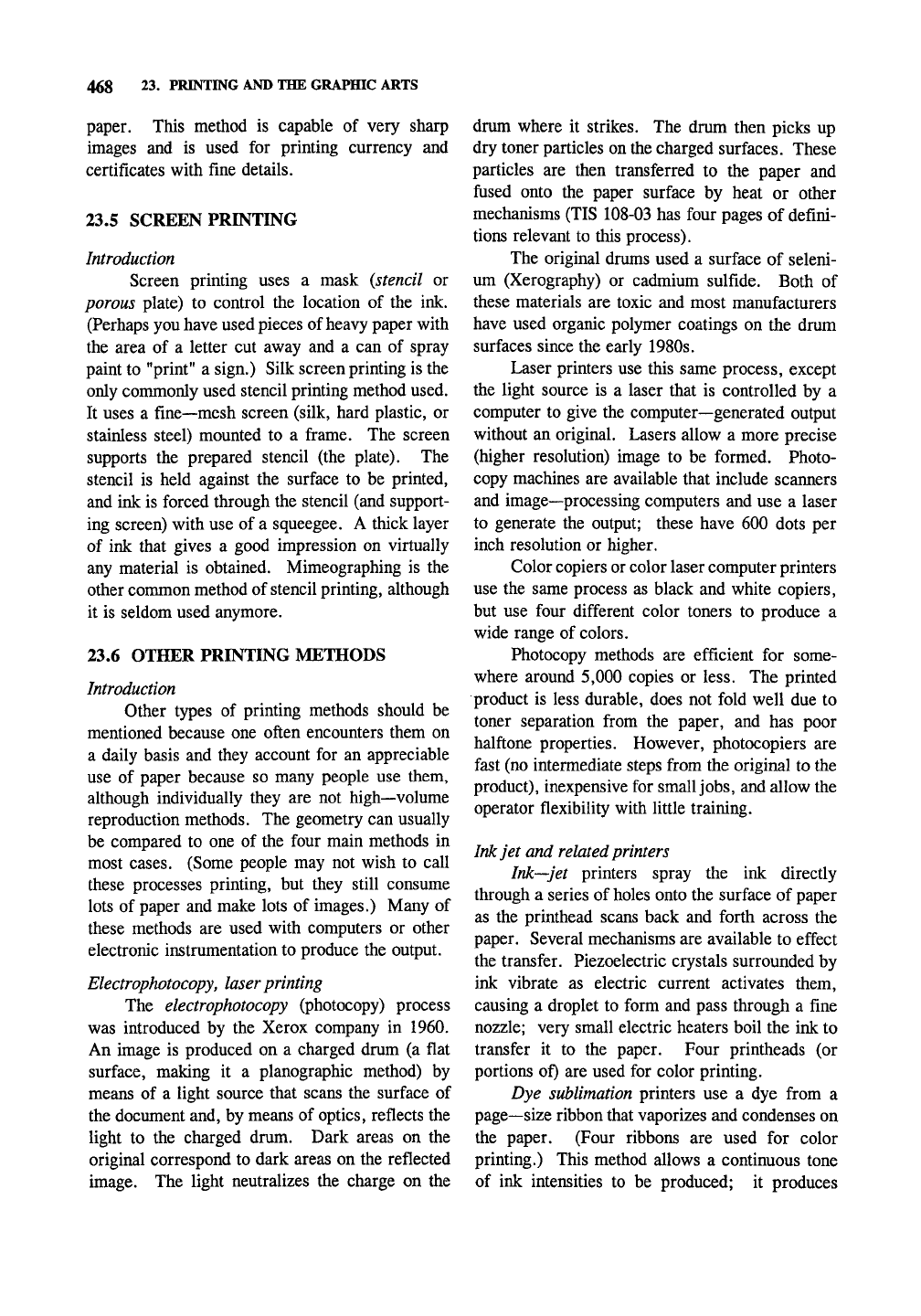
468 23. PRINTING AND THE GRAPHIC ARTS
paper. This method is capable of very sharp
images and is used for printing currency and
certificates with fine details.
23.5 SCREEN PRINTING
Introduction
Screen printing uses a mask {stencil or
porous plate) to control the location of the ink.
(Perhaps you have used pieces of heavy paper with
the area of a letter cut away and a can of spray
paint to "print" a sign.) Silk screen printing is the
only commonly used stencil printing method used.
It uses a fine—mesh screen (silk, hard plastic, or
stainless steel) mounted to a frame. The screen
supports the prepared stencil (the plate). The
stencil is held against the surface to be printed,
and ink is forced through the stencil (and support-
ing screen) with use of a squeegee. A thick layer
of ink that gives a good impression on virtually
any material is obtained. Mimeographing is the
other common method of stencil printing, although
it is seldom used anymore.
23.6 OTHER PRINTING METHODS
Introduction
Other types of printing methods should be
mentioned because one often encounters them on
a daily basis and they account for an appreciable
use of paper because so many people use them,
although individually they are not high—volume
reproduction methods. The geometry can usually
be compared to one of the four main methods in
most cases. (Some people may not wish to call
these processes printing, but they still consume
lots of paper and make lots of images.) Many of
these methods are used with computers or other
electronic instrumentation to produce the output.
Electrophotocopy, laser printing
The electrophotocopy (photocopy) process
was introduced by the Xerox company in 1960.
An image is produced on a charged drum (a flat
surface, making it a planographic method) by
means of a light source that scans the surface of
the document and, by means of optics, reflects the
light to the charged drum. Dark areas on the
original correspond to dark areas on the reflected
image. The light neutralizes the charge on the
drum where it strikes. The drum then picks up
dry toner particles on the charged surfaces. These
particles are then transferred to the paper and
fused onto the paper surface by heat or other
mechanisms (TIS 108-03 has four pages of defini-
tions relevant to this process).
The original drums used a surface of seleni-
um (Xerography) or cadmium sulfide. Both of
these materials are toxic and most manufacturers
have used organic polymer coatings on the drum
surfaces since the early 1980s.
Laser printers use this same process, except
the light source is a laser that is controlled by a
computer to give the computer—generated output
without an original. Lasers allow a more precise
(higher resolution) image to be formed. Photo-
copy machines are available that include scanners
and image—processing computers and use a laser
to generate the output; these have 600 dots per
inch resolution or higher.
Color copiers or color laser computer printers
use the same process as black and white copiers,
but use four different color toners to produce a
wide range of colors.
Photocopy methods are efficient for some-
where around
5,000
copies or less. The printed
product is less durable, does not fold well due to
toner separation from the paper, and has poor
halftone properties. However, photocopiers are
fast (no intermediate steps from the original to the
product), inexpensive for
small
jobs,
and allow the
operator flexibility with little training.
Inkjet and related printers
Ink—jet printers spray the ink directly
through a series of holes onto the surface of paper
as the printhead scans back and forth across the
paper. Several mechanisms are available to effect
the transfer. Piezoelectric crystals surrounded by
ink vibrate as electric current activates them,
causing a droplet to form and pass through a fine
nozzle; very small electric heaters boil the ink to
transfer it to the paper. Four printheads (or
portions of) are used for color printing.
Dye sublimation printers use a dye from a
page—size ribbon that vaporizes and condenses on
the paper. (Four ribbons are used for color
printing.) This method allows a continuous tone
of ink intensities to be produced; it produces
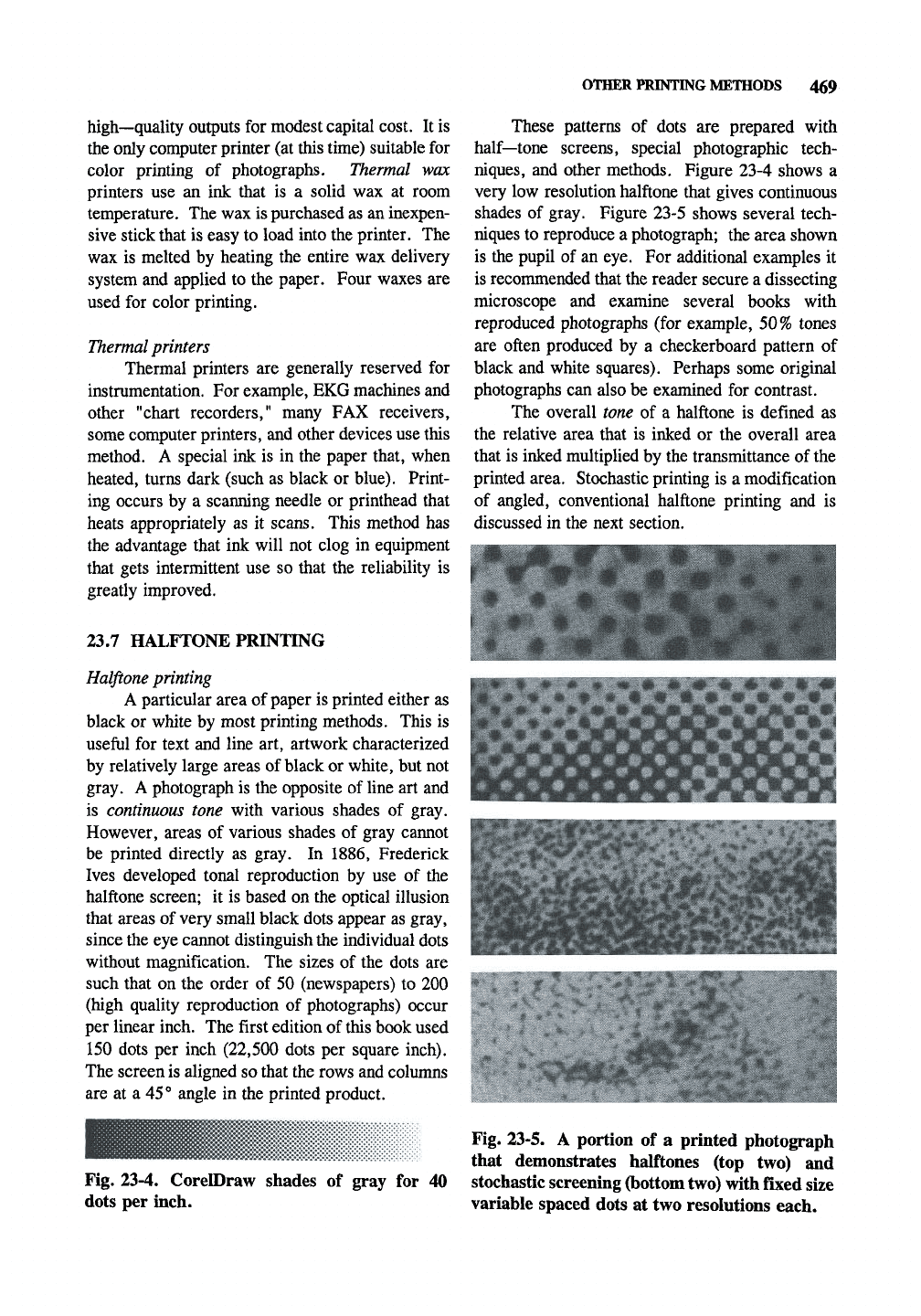
OTHER PRINTING METHODS 469
high—quality outputs for modest capital cost. It is
the only computer printer (at this time) suitable for
color printing of photographs. Thermal wax
printers use an ink that is a solid wax at room
temperature. The wax is purchased as an inexpen-
sive stick that is easy to load into the printer. The
wax is melted by heating the entire wax delivery
system and applied to the paper. Four waxes are
used for color printing.
Thermal
printers
Thermal printers are generally reserved for
instrumentation. For example, EKG machines and
other "chart recorders," many FAX receivers,
some computer printers, and other devices use this
method. A special ink is in the paper that, when
heated, turns dark (such as black or blue). Print-
ing occurs by a scanning needle or printhead that
heats appropriately as it scans. This method has
the advantage that ink will not clog in equipment
that gets intermittent use so that the reliability is
greatly improved.
23.7 HALFTONE PRINTING
Halftone printing
A particular area of paper is printed either as
black or white by most printing methods. This is
useful for text and line art, artwork characterized
by relatively large areas of black or white, but not
gray. A photograph is the opposite of line art and
is continuous tone with various shades of gray.
However, areas of various shades of gray cannot
be printed directly as gray. In 1886, Frederick
Ives developed tonal reproduction by use of the
halftone screen; it is based on the optical illusion
that areas of very small black dots appear as gray,
since the eye cannot distinguish the individual dots
without magnification. The sizes of the dots are
such that on the order of 50 (newspapers) to 200
(high quality reproduction of photographs) occur
per linear inch. The first edition of
this
book used
150 dots per inch (22,500 dots per square inch).
The screen is aligned so that the rows and columns
are at a 45° angle in the printed product.
Fig. 23-4. CorelDraw shades of gray for 40
dots per inch.
These patterns of dots are prepared with
half—tone screens, special photographic tech-
niques, and other methods. Figure 23-4 shows a
very low resolution halftone that gives continuous
shades of gray. Figure 23-5 shows several tech-
niques to reproduce a photograph; the area shown
is the pupil of an eye. For additional examples it
is recommended that the reader secure a dissecting
microscope and examine several books with
reproduced photographs (for example, 50% tones
are often produced by a checkerboard pattern of
black and white squares). Perhaps some original
photographs can also be examined for contrast.
The overall tone of a halftone is defined as
the relative area that is inked or the overall area
that is inked multiplied by the transmittance of the
printed area. Stochastic printing is a modification
of angled, conventional halftone printing and is
discussed in the next section.
Fig. 23-5. A portion of a printed photograph
that demonstrates halftones (top two) and
stochastic screening (bottom two) with fixed size
variable spaced dots at two resolutions each.
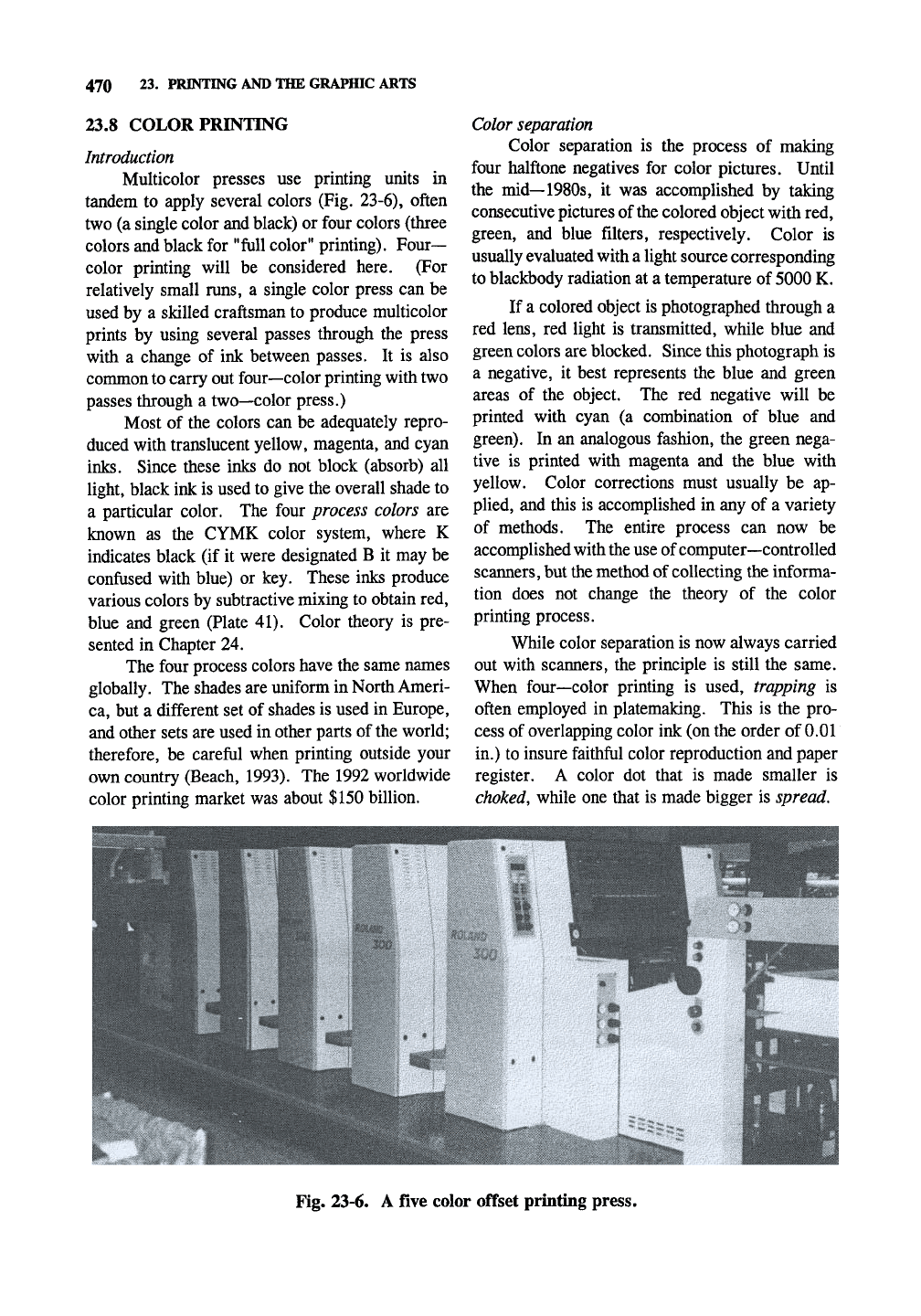
470 23. PRINTING AND THE GRAPHIC ARTS
23.8 COLOR PRINTING
Introduction
Multicolor presses use printing units in
tandem to apply several colors (Fig. 23-6), often
two (a single color and black) or four colors (three
colors and black for "full color" printing). Four-
color printing will be considered here. (For
relatively small runs, a single color press can be
used by a skilled craftsman to produce multicolor
prints by using several passes through the press
with a change of ink between passes. It is also
common
to
carry out four—color printing with two
passes through a two—color press.)
Most of the colors can be adequately repro-
duced with translucent yellow, magenta, and cyan
inks.
Since these inks do not block (absorb) all
light, black ink is used to give the overall shade to
a particular color. The four process colors are
known as the CYMK color system, where K
indicates black (if it were designated B it may be
confused with blue) or key. These inks produce
various colors by subtractive mixing to obtain red,
blue and green (Plate 41). Color theory is pre-
sented in Chapter 24.
The four process colors have the same names
globally. The shades are uniform in North Ameri-
ca, but a different set of shades is used in Europe,
and other sets are used in other parts of
the
world;
therefore, be careful when printing outside your
own country (Beach, 1993). The 1992 worldwide
color printing market was about $150 billion.
Color
separation
Color separation is the process of making
four halftone negatives for color pictures. Until
the mid—1980s, it was accomplished by taking
consecutive pictures of the colored object with red,
green, and blue filters, respectively. Color is
usually evaluated with a light source corresponding
to blackbody radiation at a temperature of 5000 K.
If a colored object is photographed through a
red lens, red light is transmitted, while blue and
green colors are blocked. Since this photograph is
a negative, it best represents the blue and green
areas of the object. The red negative will be
printed with cyan (a combination of blue and
green).
In an analogous fashion, the green nega-
tive is printed with magenta and the blue with
yellow. Color corrections must usually be ap-
plied, and this is accomplished in any of a variety
of methods. The entire process can now be
accomplished with the use of computer—controlled
scanners, but the method of collecting the informa-
tion does not change the theory of the color
printing process.
While color separation is now always carried
out with scanners, the principle is still the same.
When four—color printing is used, trapping is
often employed in platemaking. This is the pro-
cess of overlapping color ink (on the order of 0.01
in.) to insure faithful color reproduction and paper
register. A color dot that is made smaller is
choked,
while one that is made bigger is
spread.
Fig. 23-6. A five color offset printing press.
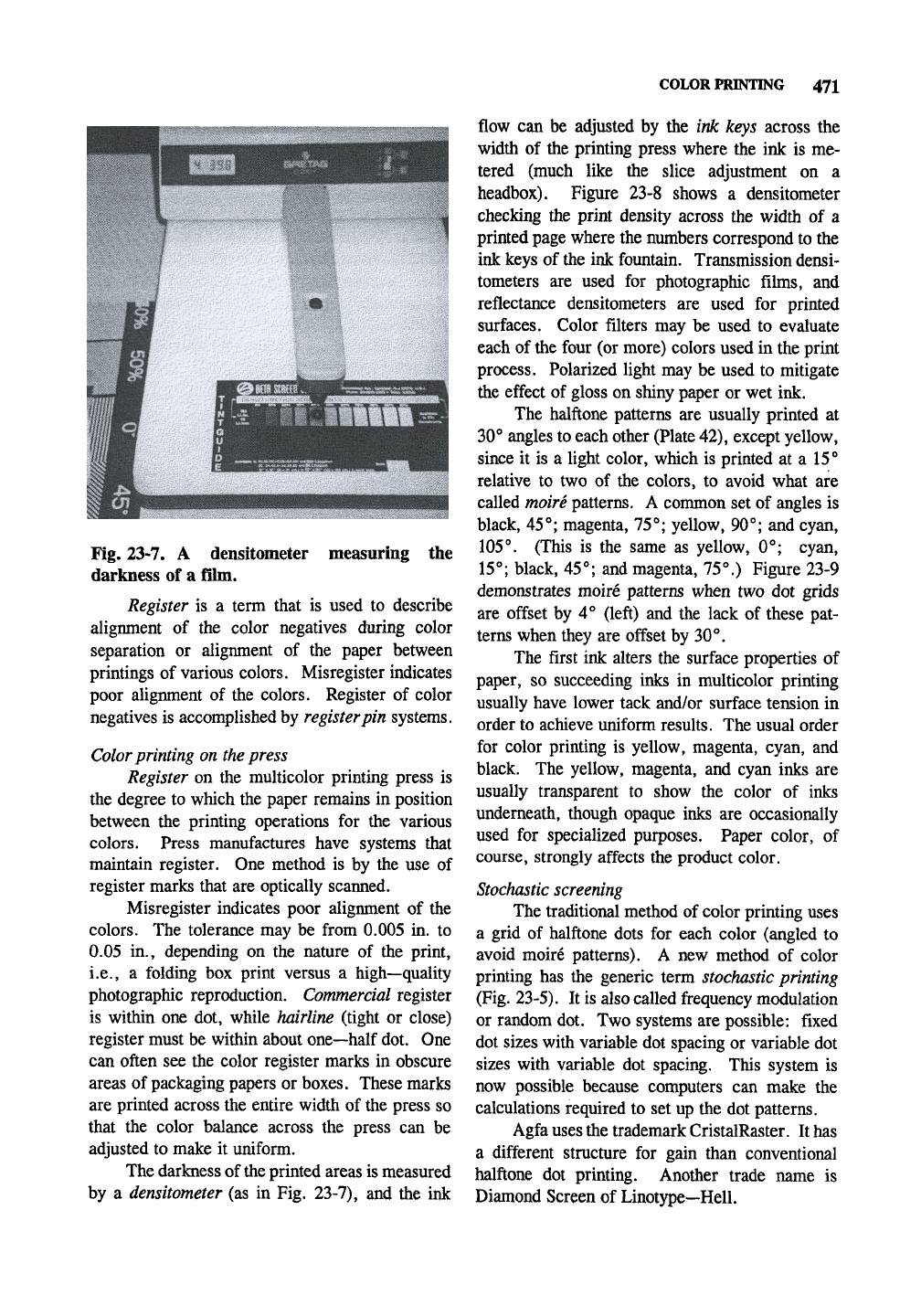
COLOR PRINTING 471
Fig. 23-7. A densitometer
darkness of a film.
measuring the
Register is a term that is used to describe
alignment of the color negatives during color
separation or alignment of the paper between
printings of various colors. Misregister indicates
poor alignment of the colors. Register of color
negatives is accomplished by register pin systems.
Color printing on the press
Register on the multicolor printing press is
the degree to which the paper remains in position
between the printing operations for the various
colors. Press manufactures have systems that
maintain register. One method is by the use of
register marks that are optically scanned.
Misregister indicates poor alignment of the
colors. The tolerance may be from 0.005 in. to
0.05 in., depending on the nature of the print,
i.e., a folding box print versus a high—quality
photographic reproduction. Commercial register
is within one dot, while hairline (tight or close)
register must be within about one—half dot. One
can often see the color register marks in obscure
areas of packaging papers or boxes. These marks
are printed across the entire width of the press so
that the color balance across the press can be
adjusted to make it uniform.
The darkness of
the
printed areas is measured
by a densitometer (as in Fig. 23-7), and the ink
flow can be adjusted by the ink keys across the
width of the printing press where the ink is me-
tered (much like the slice adjustment on a
headbox). Figure 23-8 shows a densitometer
checking the print density across the width of a
printed page where the numbers correspond to the
ink keys of the ink fountain. Transmission densi-
tometers are used for photographic films, and
reflectance densitometers are used for printed
surfaces. Color filters may be used to evaluate
each of
the
four (or more) colors used in the print
process. Polarized light may be used to mitigate
the effect of gloss on shiny paper or wet ink.
The halftone patterns are usually printed at
30° angles to each other (Plate 42), except yellow,
since it is a light color, which is printed at a 15°
relative to two of the colors, to avoid what are
called moire patterns. A common set of angles is
black, 45°; magenta, 75°; yellow, 90°; and cyan,
105°.
(This is the same as yellow, 0°; cyan,
15°;
black, 45°; and magenta, 75°.) Figure 23-9
demonstrates moire patterns when two dot grids
are offset by 4° (left) and the lack of these pat-
terns when they are offset by 30°.
The first ink alters the surface properties of
paper, so succeeding inks in multicolor printing
usually have lower tack and/or surface tension in
order to achieve uniform results. The usual order
for color printing is yellow, magenta, cyan, and
black. The yellow, magenta, and cyan inks are
usually transparent to show the color of inks
underneath, though opaque inks are occasionally
used for specialized purposes. Paper color, of
course, strongly affects the product color.
Stochastic screening
The traditional method of color printing uses
a grid of halftone dots for each color (angled to
avoid moire patterns). A new method of color
printing has the generic term stochastic printing
(Fig. 23-5). It is also called frequency modulation
or random dot. Two systems are possible: fixed
dot sizes with variable dot spacing or variable dot
sizes with variable dot spacing. This system is
now possible because computers can make the
calculations required to set up the dot patterns.
Agfa uses the trademark CristalRaster. It has
a different structure for gain than conventional
halftone dot printing. Another trade name is
Diamond Screen of Linotype—Hell.
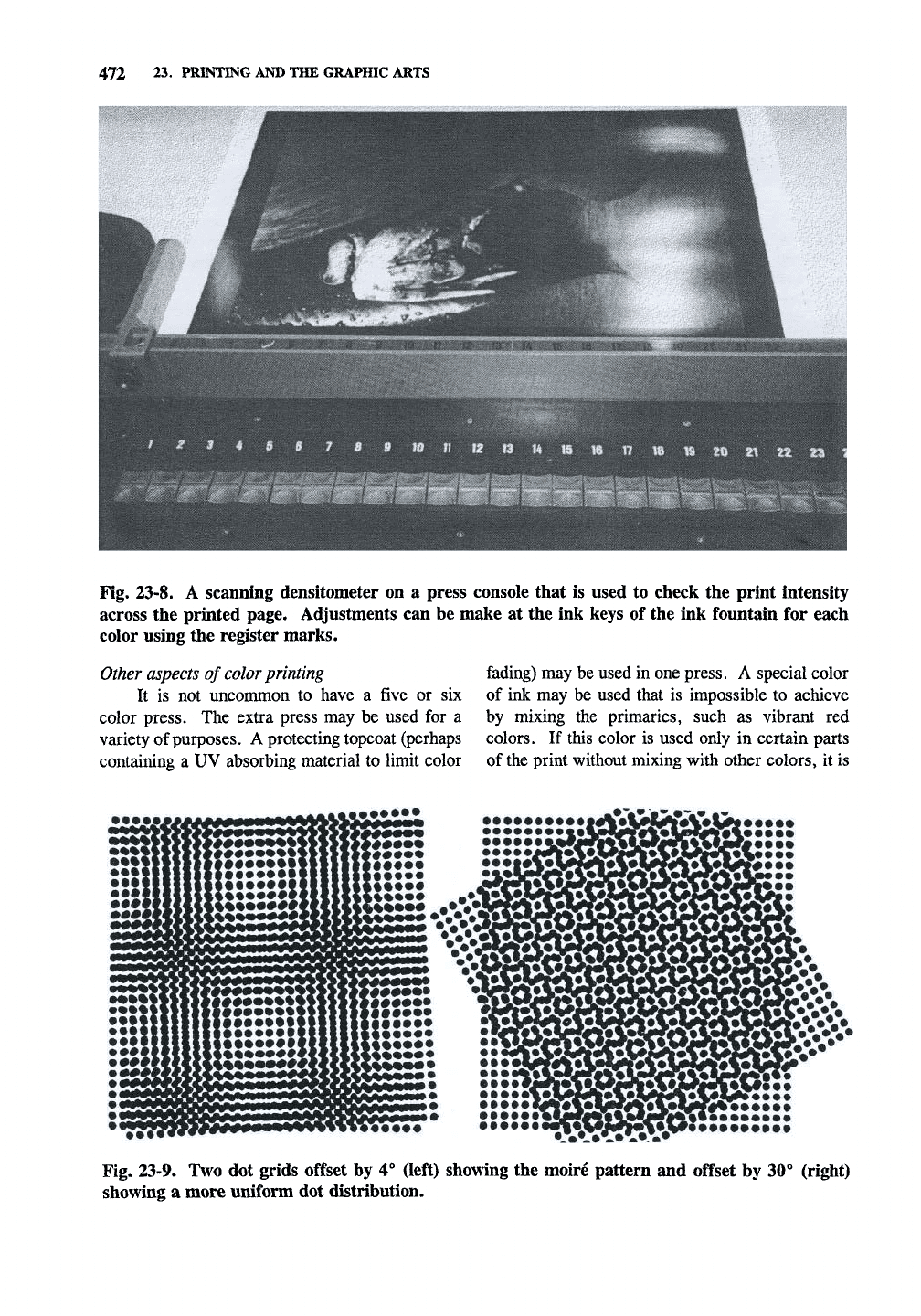
472 23. PRINTING AND THE GRAPHIC ARTS
S:.f ^H "^.'"T^S densitometer on a press console that is used to check the print intensity
Other aspects of color printing
It is not uncommon to have a five or six
color press. The extra press may be used for a
variety of purposes. A protecting topcoat (perhaps
containing a UV absorbing material to limit color
fading) may be used in one press. A special color
of ink may be used that is impossible to achieve
by mixing the primaries, such as vibrant red
colors. If this color is used only in certain parts
of the print without mixing with other colors, it is
•••J
»•#•••
Fig. 23-9. Two dot grids offset by 4» Oeft) showing the moire pattern and offset by 30» (rieht)
showmg a more uniform dot distribution. u ""sei oy jo (right)
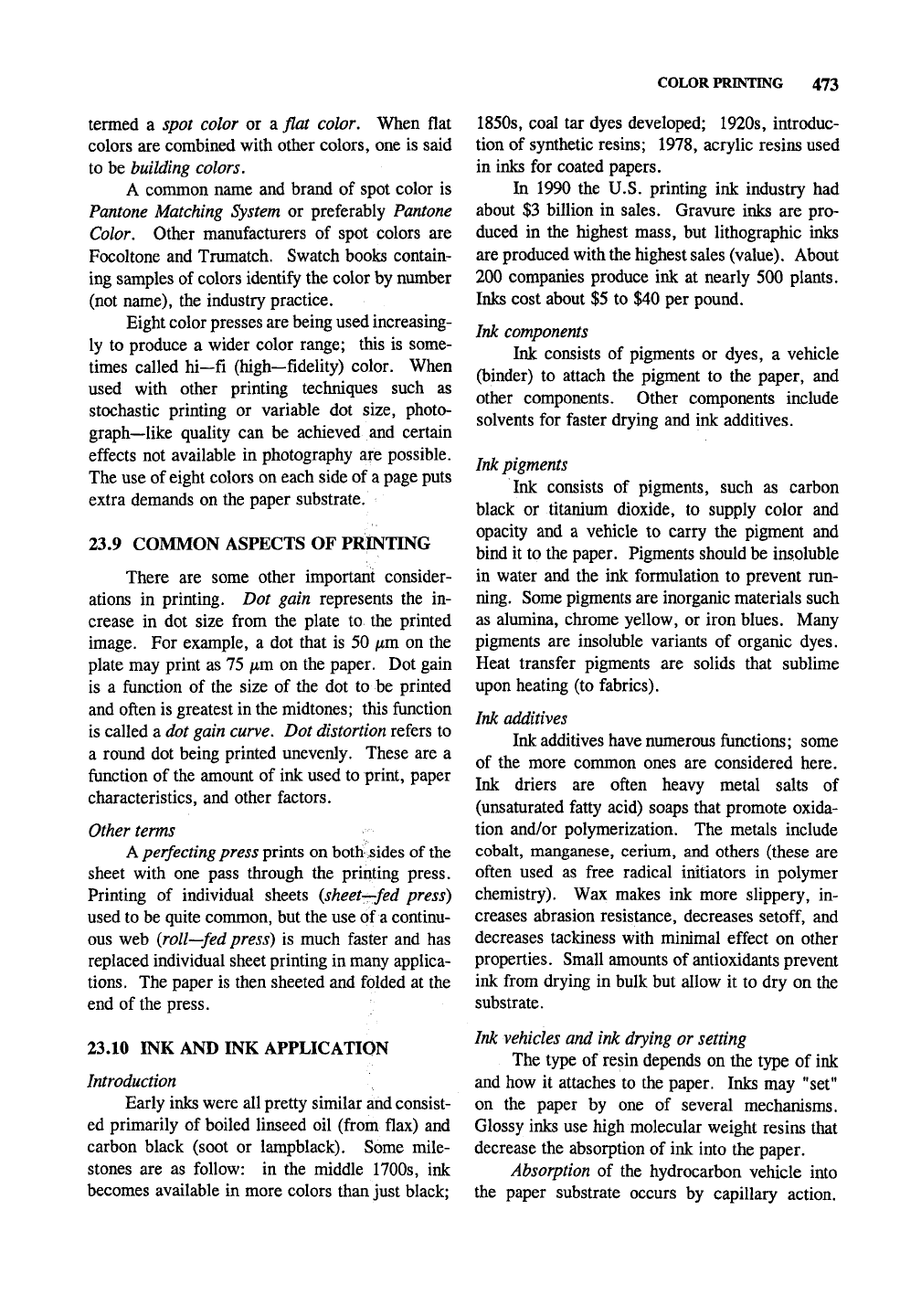
COLOR PRINTING 473
termed a spot color or a flat color. When flat
colors are combined with other colors, one is said
to be building colors.
A conmion name and brand of spot color is
Pantone Matching System or preferably Pantone
Color. Other manufacturers of spot colors are
Focoltone and Trumatch. Swatch books contain-
ing samples of colors identify the color by number
(not name), the industry practice.
Eight color presses are being used increasing-
ly to produce a wider color range; this is some-
times called hi—fi (high—fidelity) color. When
used with other printing techniques such as
stochastic printing or variable dot size, photo-
graph—like quality can be achieved and certain
effects not available in photography are possible.
The use of eight colors on each side of a page puts
extra demands on the paper substrate.
23.9 COMMON ASPECTS OF PRBVTEVG
There are some other important consider-
ations in printing. Dot gain represents the in-
crease in dot size from the plate to the printed
image. For example, a dot that is 50 /xm on the
plate may print as 75 /xm on the paper. Dot gain
is a function of the size of the dot to be printed
and often is greatest in the midtones; this function
is called a dot
gain
curve. Dot
distortion
refers to
a round dot being printed unevenly. These are a
function of the amount of ink used to print, paper
characteristics, and other factors.
Other terms
A
perfecting press prints on both sides of the
sheet with one pass through the printing press.
Printing of individual sheets (sheet^rfed press)
used to be quite common, but the use of a continu-
ous web
(roll—fed
press) is much faster and has
replaced individual sheet printing in many applica-
tions.
The paper is then sheeted and folded at the
end of the press.
23.10 INK AND INK APPLICATION
Introduction
Early inks were all pretty similar and consist-
ed primarily of boiled linseed oil (from flax) and
carbon black (soot or lampblack). Some mile-
stones are as follow: in the middle 1700s, ink
becomes available in more colors than just black;
1850s, coal tar dyes developed; 1920s, introduc-
tion of synthetic resins; 1978, acrylic resins used
in inks for coated papers.
In 1990 the U.S. printing ink industry had
about $3 billion in sales. Gravure inks are pro-
duced in the highest mass, but lithographic inks
are produced with the highest sales (value). About
200 companies produce ink at nearly 500 plants.
Inks cost about $5 to $40 per pound.
Ink components
Ink consists of pigments or dyes, a vehicle
(binder) to attach the pigment to the paper, and
other components. Other components include
solvents for faster drying and ink additives.
Ink pigments
Ink consists of pigments, such as carbon
black or titanium dioxide, to supply color and
opacity and a vehicle to carry the pigment and
bind it to the paper. Pigments should be insoluble
in water and the ink formulation to prevent run-
ning. Some pigments are inorganic materials such
as alumina, chrome yellow, or iron blues. Many
pigments are insoluble variants of organic dyes.
Heat transfer pigments are solids that sublime
upon heating (to fabrics).
Ink
additives
Ink additives have numerous functions; some
of the more common ones are considered here.
Ink driers are often heavy metal salts of
(unsaturated fatty acid) soaps that promote oxida-
tion and/or polymerization. The metals include
cobalt, manganese, cerium, and others (these are
often used as free radical initiators in polymer
chemistry). Wax makes ink more slippery, in-
creases abrasion resistance, decreases
setoff,
and
decreases tackiness with minimal effect on other
properties. Small amounts of antioxidants prevent
ink from drying in bulk but allow it to dry on the
substrate.
/«/:
vehicles and ink drying or setting
The type of resin depends on the type of ink
and how it attaches to the paper. Inks may "set"
on the paper by one of several mechanisms.
Glossy inks use high molecular weight resins that
decrease the absorption of ink into the paper.
Absorption of the hydrocarbon vehicle into
the paper substrate occurs by capillary action.
